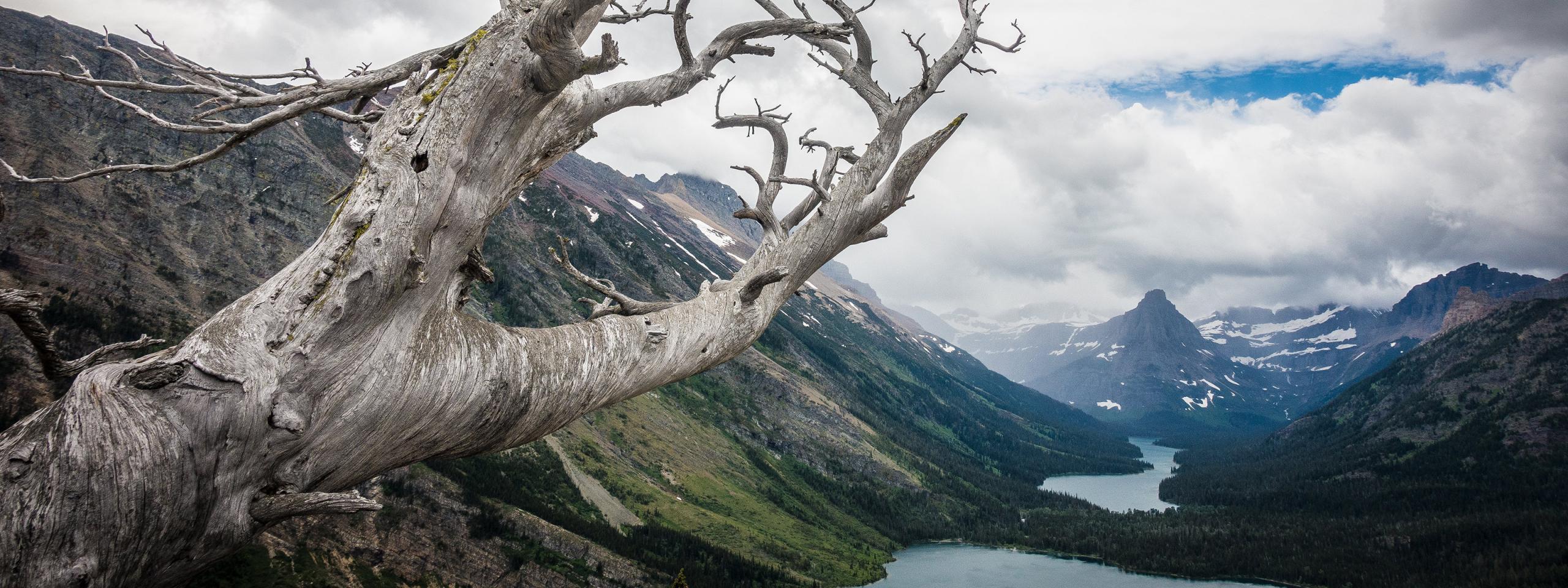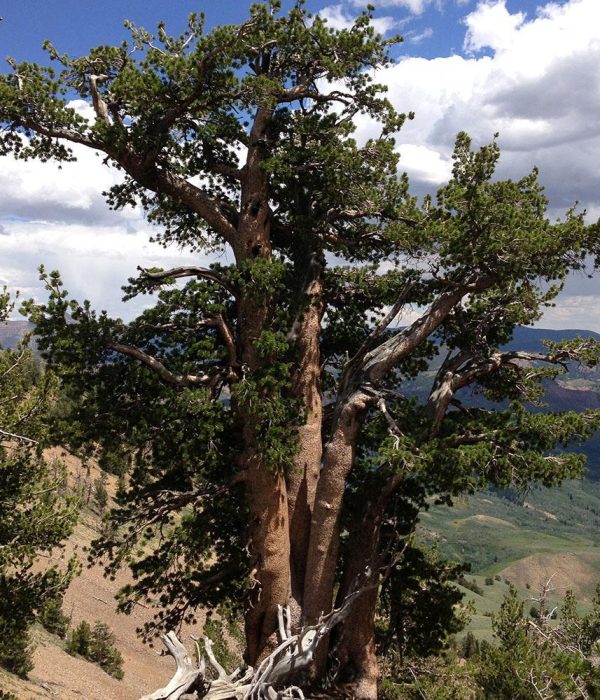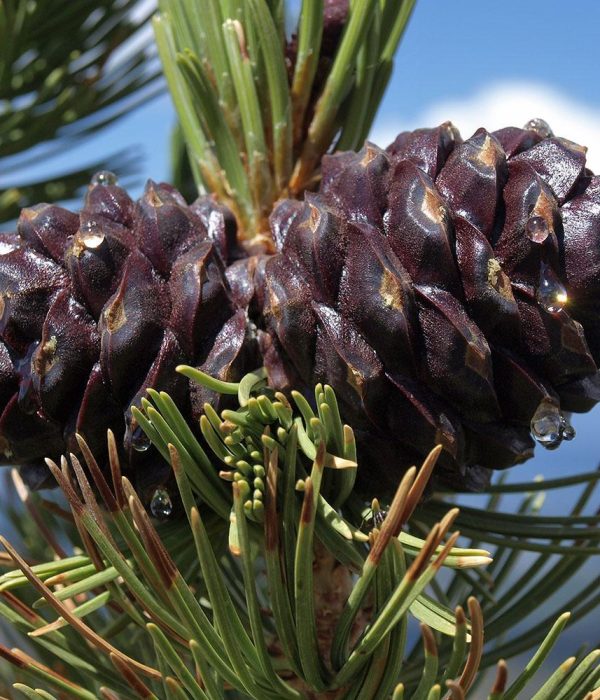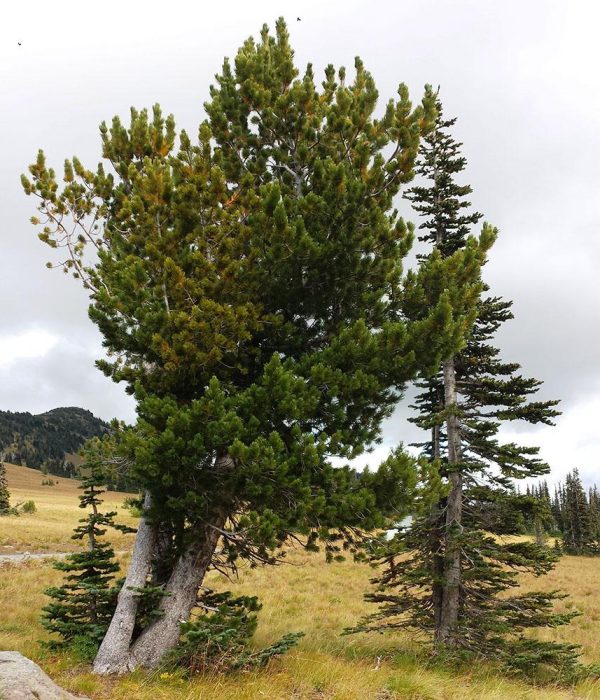
Director of the Indigenous Leadership Program
Whitebark pine tree (photo credit: GlacierNPS). Circle images: Mike Durglo and old whitebark pine tree Ilawye. Photo courtesy of Michael Durglo, Jr.
On a beautiful sunny day in the traditional homelands of the Confederated Salish and Kootenai Tribes in western Montana, Michael Durglo, Jr., director of the Tribes’ Tribal Historic Preservation Office, virtually spoke with Brent Davies, Emilie Chen, and Lisa Watt about the Tribes’ preservation efforts of the whitebark pine tree and why those efforts are important. He also talked about climate change, the impacts he has witnessed in his homeland, and how humans need to shift our thinking to be more conscientious of all life around us.
This interview was conducted through a partnership with the Bonneville Environmental Foundation with funding provided by the Climate Resilience Fund for the Treeline Project. It was first published in the December issue of the Treeline newsletter.
On my screen background, you can see a picture of an old whitebark pine tree with me standing next to it. I call it my Ilawye. In Salish, Ilawye means “great-great-grandparent.” At one time, I was thinking Ilawye was around 3000 years old but we don’t know that for sure. We’d like to take a core sample but we’re debating about that because it’s a special tree. I call it my medicine tree. It’s good medicine to go up there and be in that place.
[Our Forestry Department] was talking about that tree for about two years before I actually walked up there and got to touch it. It was just big and beautiful. That was a real special time for me. It became, I would say, a spiritual experience.
What have you witnessed in terms of climate change impacts?
People have a hard time seeing the impacts of climate change. But I tell them, look up on the top of those mountains. All those trees are dying. That’s a result of climate change. We’re also seeing many more intense wind and rain events that historically we’ve never seen before.
I think the most visible impact of climate change we see here is the melting glaciers. We historically had glaciers in the Mission Mountains. I remember my grandfather telling me, “Mike, you see that glacier up there on the side of that mountain, right there? When that glacier melts, you go up there, and you’ll find gold.”
“
And I was like, “Yeah right, like that glacier’s ever gonna melt.” And in those years, it never did. Now, every year, all the snow melts off the mountains. Glacier National Park is just a couple hours north of us, and as you all know, Glacier National Park is losing glaciers every year. They predict that within 20 years all the glaciers will be gone.

Whitebark pine tree. Photo credit: Glacier National Park Service
Without thinking about it, a lot of what we were doing already was mitigating the impacts of climate change. A lot of the stream restoration work that we’ve been doing for many, many years, that’s climate mitigation. We just didn’t call it that. We just knew that these streams are warming up, and those trout species, those salmonids, need cold water. We just said, “Okay, we’re gonna restart the stream because we’re losing cold water refugia.” This was combined with our concern of earlier runoff from the mountains.
We were one of the first tribes in the country to develop a climate change plan. We started that process in 2012, with the full understanding of our tribal council, our leadership, that this will be a living document. It’s always going to be a work in progress. At the time, I was the environmental director so they asked me if I would coordinate the effort of developing a plan. I had never done anything like that before but I said, “Absolutely, I’ll do this.”
I started going to the Institute for Tribal Environmental Professionals’ Climate Change Adaptation Planning Workshop. I was also the co-chair of the National Tribal Science Council and the chair of the Region 8 Tribal Operations Committee, which consists of EPA environmental directors in Montana, Wyoming, Colorado, Utah, and North and South Dakota. So we were talking about climate change a couple years before we even started working on our plan.
What are the Tribes doing to address climate change?
Prior to developing our Climate Change Strategic Plan, whitebark pine was really not a big concern of ours. Historically, we are a timber resource tribe—we rely on timber sales and timber harvest for a large part of our budget every year. Whitebark pine is not one of those species that we harvest. It grows above 6,000 feet, up in rocky areas, and it grows very, very slowly. I don’t say that whitebark pine was not a part of our forest management plan, but until we developed a [climate] plan, we realized that there were multiple things going on. [Our] Forestry Department started looking at maps to figure out how many acres we have of whitebark pine on the reservation. We saw that instead of 30,000 acres of this tree, there’s 90,000, so there’s three times as many [as we thought].

Whitebark pine tree. Photo credit: Famartin
There’s a video I’d like to share with you, called Ghost Forest. It’s a video we put together about the impacts of climate change and pine beetles and blister rust on our whitebark pine. It talks about how the water flows and how if the whitebark pine isn’t there, that water comes out fast and hard. And when it’s fast and hard, it picks up sediments, so it’s just dirty. When it comes out slow and easy, it’s clean, it’s pure, it has that chance for all those little macro and micro invertebrates to do their work. Whitebark pine helps retain snowpack. It’s a keystone species for over 100 different animals. And it’s culturally significant to us.
Also, we’re working on a virtual reality series around whitebark pine and the Clark’s Nutcracker, a bird that distributes the seeds. The seeds and the cones of the whitebark pine grow right at the very top of the tree. They’re not dispersed throughout the whole tree like on a ponderosa pine or lodgepole pine.
“
[Members of our Forestry Department climb] up to the top, and they put cages on the cones in the spring. First of all, they have to find a healthy tree, a resilient tree—we call it a plus tree—that has been resilient to blister rust or pine beetles. Then, in the fall, they climb it again, gather all the cones, and send those to the lab in Coeur d’Alene, Idaho, where they do genetic testing. We’re really trying to find the most resilient seeds so we can grow the most resilient trees.
For example, the seedlings that [the Tribes] have growing in the greenhouse, they have to let those grow for three or four years before they can actually plant them in the ground. It takes about 30 or 40 years before the tree can start producing its own cones. Last year was the first year in our history that the Forestry Department planted 3,000 seedlings. I’ll never see those come to maturity in my lifetime but that’s not what it’s about. What we’re doing is trying to make this place a better place for those to come. It’s about the future.
To me, it’s like our own story of survival, of resilience.

Whitebark pine cones. Photo credit: Jim Morefield
What’s next?
In talking with the Forest Service, one of our questions was: Can you please make sure that we will still be able to have access to certain areas if we want to gather whitebark pine nuts and cones? Please make sure we’ll be able to do that. Because of the potential listing of whitebark pine [as an endangered species], they were thinking it could have an impact on the amount of cones we can collect. We have never collected cones off the reservation but we think it’s important that that availability is there.
Based on the new [climate] models, what we thought was going to happen in 50 years is happening now. We’ve been working on rewriting our climate plan and part of that is to include more traditional knowledge and more cultural significance around food sovereignty, food security, and First Foods. Today, I was talking to some of the folks that were going to do a video recording and the people who prepared our lunch that, someday, it would be nice to have the experience of tasting those whitebark pine seeds again at a traditional feast. That’ll happen someday, I hope in my lifetime.
I talk a lot about climate change impacts on cultural resources and how they are impacting what is happening to our food, our medicine. Every year I try to bring on as many interns as I can from the Salish Kootenai College and just pull them onto the boat and tell them, “Grab an oar and start rowing, man. We need all the help we can get getting this boat up the river.” That’s where we’re headed.
Are you hopeful?
I am hopeful because there is no other way. I mean, we don’t get a second chance. Just look around and think about all the species that we’re losing daily and the impact. It’s everything from different trees, different plants, different animals, different insects.
Once I had what I call an “awake vision.” Early one morning, I woke up at about three o’clock and I saw, up on the top of the mountain, a pika. It’s a little rodent that depends on the cold and high elevation. Kind of like whitebark pine, it lives up there; that’s its habitat, cold and high. They’re just cute little fuzzy creatures. They cannot go any higher. They’re at the top of the mountain.
What I saw was the last pika on top of that mountain. And when that pika died, I saw a deer, right out there in my field. She lifted her head and looked around. It was like something just happened. Like she didn’t really know what it was but she knew that something just happened in the sacred circle of life.
Everything in that circle is connected. And when we lose bits and pieces of that circle—I mean, we’re losing a big piece of that circle now—it has to readjust itself. When we nearly wiped out the wolf, which is the highest predator on the totem pole, that circle took 100 years to mend and adjust. Now here we come and put the wolf back in and all of a sudden the circle has to adjust again and it takes another 100 years. I’m not saying that it’s a bad thing to put [the wolves] back in, but we really need to think about how the circle mends and adjusts.
I think the responsibility that we have as human beings is to be part of the circle. The reason a lot of this stuff like climate change is happening is because we took ourselves out of it. Until people understand that, the circle is really going to be hard to mend, to put it back together.

Whitebark pine tree. Photo credit: Brewbooks
Thank you, Mike.
Michael Durglo, Jr. is the Department Head of the Confederated Salish and Kootenai Tribes’ (CSKT) Tribal Historic Department and has been a leader in climate change adaptation work for nearly a decade. He facilitated the development of a Flathead Reservation Climate Change Strategic Plan for CSKT, the third Tribe to do so in the United States. After completing the plan, he continued to build on the work by diving deep into the perspectives of the elders and integrating traditional knowledge into the plan. Particularly unique has been Michael’s all-inclusive and open approach towards climate planning. He has established monthly meetings of a Climate Change Advisory Committee and welcomes all stakeholders, both tribal and non-tribal. This has opened conversations among multiple jurisdictions, connecting people and adding value to solving the problems that will be faced by the impacts of climate change into the future.

VIDEO
In the high country, it’s an uphill battle to save the imperiled white bark pine.

VIDEO
CSKT Tribal Historic Preservation Department Trailer about the restoration process of the White Bark Pine.